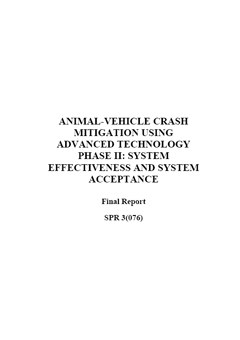Publications
Animal Vehicle Crash Mitigation Using Advanced Technology
| Year of publication | 2009 |
|---|---|
| Author(s) | Marcel P. Huijser |
| Co-authors | T.D. Holland, A.V. Kociolek, A.M. Barkdoll and J.D. Schwalm |
| Publisher(s) | Montana State University Western Transportation Institute Website: http://www.montana.edu/ |
| Place of publication | Bozeman |
| Language | en |
| Price | free |
| Purchase | |
| Page(s) | 162 |
| Publication type | Other |
As a result of steep slopes and curves, the developed system of Phase I had blind spots where large animals were able to approach the road undetected. Therefore the warning signs could not be attached, and the effectiveness of the system in reducing vehicle speed and in reducing the number of collisions with large wild animals could not be evaluated.
In Phase II of the project, subject of the current report, system modificationsSubject of the current report is phase II oft he project, where system modifications reduced the blind spots so that the warning signs could be attached. Speed measurements showed that passenger cars, pick-ups, vans, and trucks with two units or more all had lower vehicle speed with the warning signs activated compared to warning signs off. The number of collisions with large wild animals was 58-67% lower than expected, but because of the variability in the number of collisions and only one year of post installation collision data, the researchers could not test whether this reduction was significant. The opinions on and experiences of drivers with the system were documented in interviews.
In Phase II of the project, subject of the current report, system modificationsSubject of the current report is phase II oft he project, where system modifications reduced the blind spots so that the warning signs could be attached. Speed measurements showed that passenger cars, pick-ups, vans, and trucks with two units or more all had lower vehicle speed with the warning signs activated compared to warning signs off. The number of collisions with large wild animals was 58-67% lower than expected, but because of the variability in the number of collisions and only one year of post installation collision data, the researchers could not test whether this reduction was significant. The opinions on and experiences of drivers with the system were documented in interviews.


